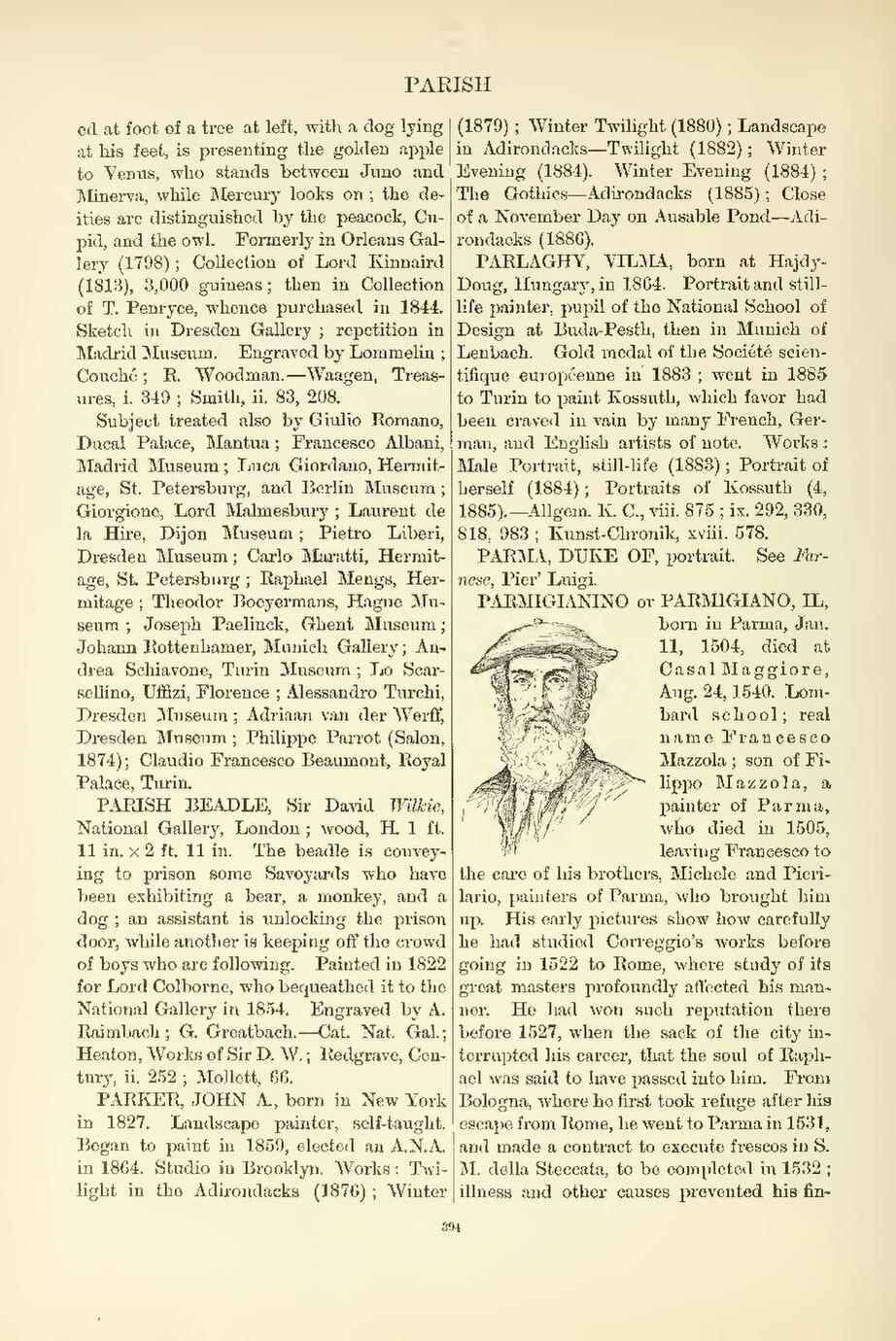- ed at foot of a tree at left, with a dog lying
at his feet, is presenting the golden apple to Venus, who stands between Juno and Minerva, while Mercury looks on; the deities are distinguished by the peacock, Cupid, and the owl. Formerly in Orleans Gallery (1798); Collection of Lord Kinnaird (1813), 3,000 guineas; then in Collection of T. Penryce, whence purchased in 1844. Sketch in Dresden Gallery; repetition in Madrid Museum. Engraved by Lommelin; Couché; R. Woodman.—Waagen, Treasures, i. 349; Smith, ii. 83, 208.
Subject treated also by Giulio Romano, Ducal Palace, Mantua; Francesco Albani, Madrid Museum; Luca Giordano, Hermitage, St. Petersburg, and Berlin Museum; Giorgione, Lord Malmesbury; Laurent de la Hire, Dijon Museum; Pietro Liberi, Dresden Museum; Carlo Maratti, Hermitage, St. Petersburg; Raphael Mengs, Hermitage; Theodor Boeyermans, Hague Museum; Joseph Paelinck, Ghent Museum; Johann Rottenhamer, Munich Gallery; Andrea Schiavone, Turin Museum; Lo Scarsellino, Uffizi, Florence; Alessandro Turchi, Dresden Museum; Adriaan van der Werff, Dresden Museum; Philippe Parrot (Salon, 1874); Claudio Francesco Beaumont, Royal Palace, Turin.
PARISH BEADLE, Sir David Wilkie,
National Gallery, London; wood, H. 1 ft.
11 in. × 2 ft. 11 in. The beadle is conveying
to prison some Savoyards who have
been exhibiting a bear, a monkey, and a
dog; an assistant is unlocking the prison
door, while another is keeping off the crowd
of boys who are following. Painted in 1822
for Lord Colborne, who bequeathed it to the
National Gallery in 1854. Engraved by A.
Raimbach; G. Greatbach.—Cat. Nat. Gal.;
Heaton, Works of Sir D. W.; Redgrave, Century,
ii. 252; Mollett, 66.
PARKER, JOHN A., born in New York
in 1827. Landscape painter, self-taught.
Began to paint in 1859, elected an A.N.A.
in 1864. Studio in Brooklyn. Works: Twilight
in the Adirondacks (1876); Winter
(1879); Winter Twilight (1880); Landscape
in Adirondacks—Twilight (1882); Winter
Evening (1884). Winter Evening (1884);
The Gothics—Adirondacks (1885); Close
of a November Day on Ausable Pond—Adirondacks
(1886).
PARLAGHY, VILMA, born at Hajdy-Doug,
Hungary, in 1864. Portrait and still-life
painter, pupil of the National School of
Design at Buda-Pesth, then in Munich of
Lenbach. Gold medal of the Société scientifique
européenne in 1883; went in 1885
to Turin to paint Kossuth, which favor had
been craved in vain by many French, German,
and English artists of note. Works:
Male Portrait, still-life (1883); Portrait of
herself (1884); Portraits of Kossuth (4,
1885).—Allgem. K. C., viii. 875; ix. 292, 330,
818, 983; Kunst-Chronik, xviii. 578.
PARMA, DUKE OF, portrait. See Farnese,
Pier' Luigi.
An image should appear at this position in the text. To use the entire page scan as a placeholder, edit this page and replace "{{missing image}}" with "{{raw image|Cyclopedia of painters and paintings (IA cyclopediaofpain03cham).pdf/416}}". Otherwise, if you are able to provide the image then please do so. For guidance, see Wikisource:Image guidelines and Help:Adding images. |
PARMIGIANINO or PARMIGIANO, IL,
born in Parma, Jan.
11, 1504, died at
Casal Maggiore,
Aug. 24, 1540. Lombard
school; real
name Francesco
Mazzola; son of Filippo
Mazzola, a
painter of Parma,
who died in 1505,
leaving Francesco to
the care of his brothers, Michele and Pierilario,
painters of Parma, who brought him
up. His early pictures show how carefully
he had studied Correggio's works before
going in 1522 to Rome, where study of its
great masters profoundly affected his manner.
He had won such reputation there
before 1527, when the sack of the city interrupted
his career, that the soul of Raphael
was said to have passed into him. From
Bologna, where he first took refuge after his
escape from Rome, he went to Parma in 1531,
and made a contract to execute frescos in S.
M. della Steccata, to be completed in 1532;
illness and other causes prevented his fin-
